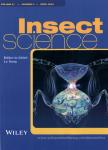Impacts of climate warming on hybrid zone movement: Geographically diffuse and biologically porous "species borders"
Impacts of climate warming on hybrid zone movement: Geographically diffuse and biologically porous "species borders"作者机构:Department of Entomology Michigan State University East Lansing Michigan McGuire Center for Lepidoptera and Biodiversity Flonda Museum of Natural History University of Florida Gainesville Florida USA
出 版 物:《Insect Science》 (昆虫科学(英文版))
年 卷 期:2011年第18卷第2期
页 面:121-159页
核心收录:
学科分类:0710[理学-生物学] 0830[工学-环境科学与工程(可授工学、理学、农学学位)] 083001[工学-环境科学] 07[理学] 08[工学] 0904[农学-植物保护] 0901[农学-作物学] 0713[理学-生态学]
基 金:This review reflects decades of personally treasured friendships and assistance from colleagues in the insectplant interactions field of study. The Papilionidae research from our laboratory was supported by such academic synergism and also in part by the National Science Foundation (DEB-9201122 DEB-9510044 DEB 0716683 DEB 0918879) and the Michigan Agricultural Experiment Station (Project # 01644). I wish to thank all laboratory members and friends for their enthusiasm and assistance over the years, and most recently, Matthew Aardema, Rodrigo Mercader and Gabe Ording. Special thanks are extended to one particularly helpful reviewer.
主 题:cryptic species divergence hitchhiking ecologiealspeciation host associateddivergence mosaic genomes range limits recombinant hybrid species phylogeography,polyspecialists species boundaries
摘 要:The ecology and evolutionary biology of insect-plant associations has real- ized extensive attention, especially during the past 60 years. The classifications (categorical designations) of continuous variation in biodiversity, ranging from global patterns (e.g., lat- itudinal gradients in species richness/diversity and degree of herbivore feeding specialization) to localized insect-plant associations that span the biospectrum from polyphenisms, polymorphisms, biotypes, demes, host races, to cryptic species, remain academically contentious. Semantic and biosystematic (taxonomical) disagreements sometimes detract from more important ecological and evolutionary processes that drive diversification, the dynamics of gene flow and local extinctions. This review addresses several aspects of insect specialization, host-associated divergence and ecological (including "hybrid") speciation, with special reference to the climate warming impacts on species borders of hybridiz- ing swallowtail butterflies (Papilionidae). Interspecific hybrid introgression may result in collapse of multi-species communities or increase species numbers via homoploid hybrid speciation. We may see diverging, merging, or emerging genotypes across hybrid zones, all part of the ongoing processes of evolution. Molecular analyses of genetic mosaics and genomic dynamics with "divergence hitchhiking", combined with ecological, ethological and physiological studies of"species porosity", have already begun to unveil some answers for some important ecological/evolutionary questions. (i) How rapidly can host-associated divergence lead to new species (and why doesn't it always do so, e.g., resulting in "incom- plete" speciation)? (ii) How might "speciation genes" function, and how/where would we find them? (iii) Can oscillations from specialists to generalists and back to specialists help explain global diversity in herbivorous insects? (iv) How could recombinant interspecific hybridization lead to divergence and speciation? From ancient phytochemically defined angiosperm affiliations to recent and very local geographical mosaics, the Papilionidae (swallowtail butterflies) have provided a model for enhanced understanding of ecological patterns and evolutionary processes, including host-associated genetic divergence, ge- nomic mosaics, genetic hitchhiking and sex-linked speciation genes. Apparent homoploid hybrid speciation in Papilio appears to have been catalyzed by climate warming-induced interspecific introgression of some, but not all, species diagnostic traits, reflecting strong divergent selection (discordant), especially on the Z (= X) chromosome. Reproductive isolation of these novel recombinant hybrid genotypes appears to be accomplished via a delayed post-diapause emergence or temporal isolation, and is perhaps aided by the thermal landscape. Changing thermal landscapes appear to have created (and may destroy) novel recombinant hybrid genotypes and hybrid species.



